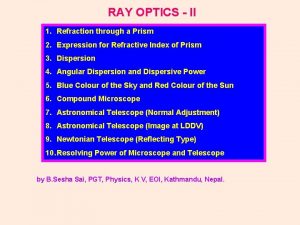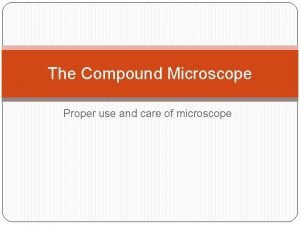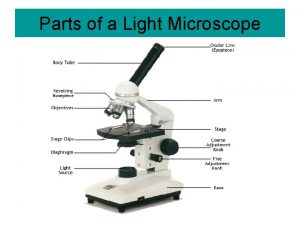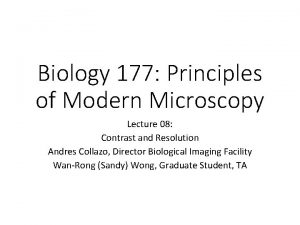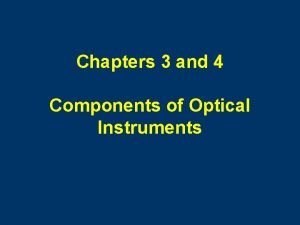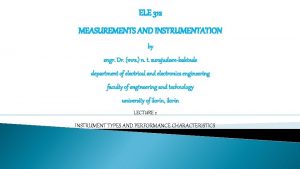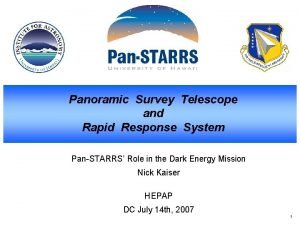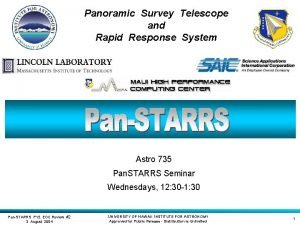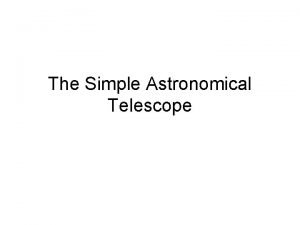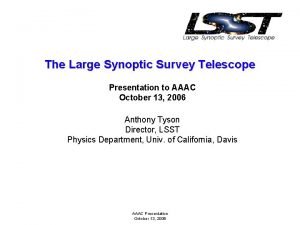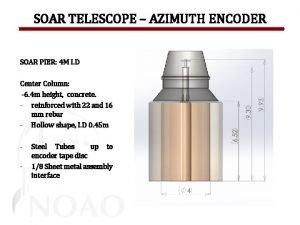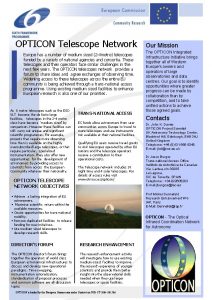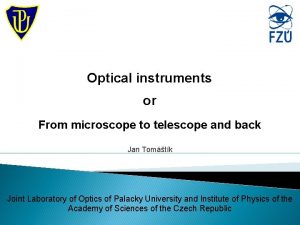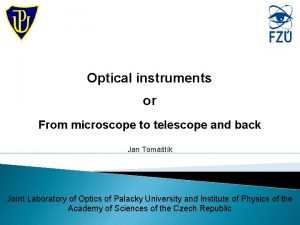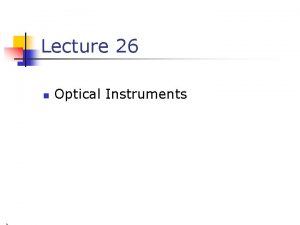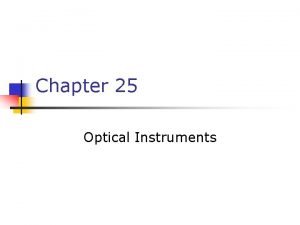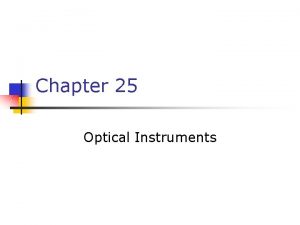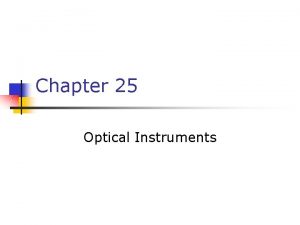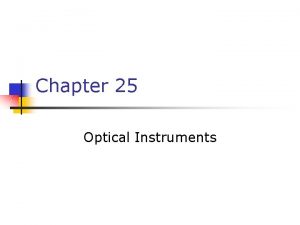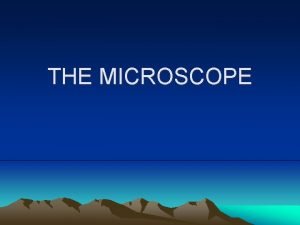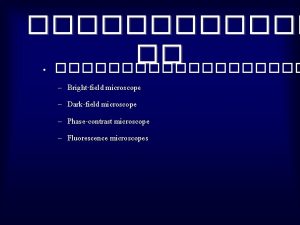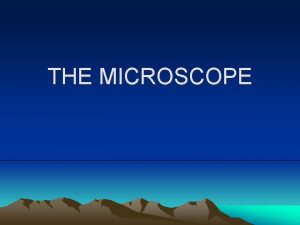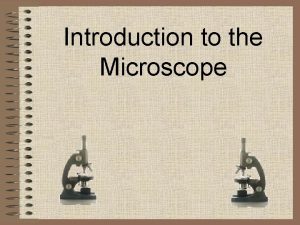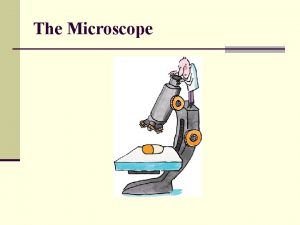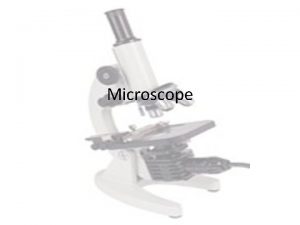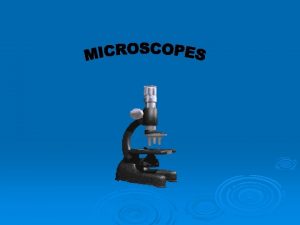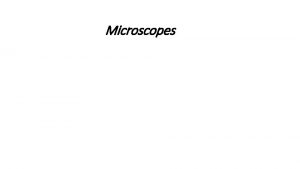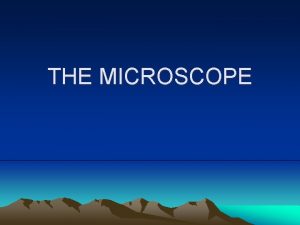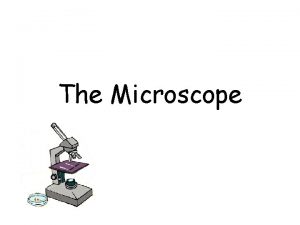Optical instruments or From microscope to telescope and
























- Slides: 24

Optical instruments or From microscope to telescope and back Jan Tomáštík Joint Laboratory of Optics of Palacky University and Institute of Physics of the Academy of Sciences of the Czech Republic

Overview Optical microscope Confocal microscope Telescope (one particular) SLO 2019

Optical microscope A complex optical instrument that increases the viewing angle of the eye, and thus improves its resolution. Multiple optical systems: Ocular and objective Objective – system of lens, that is near to the observed object. Object is placed close the objective focal plane and objective creates its real, inverted and magnified image (placed between ocular an its focal point. Objective magnification ranges from x 5 to x 100 Ocular – behaves as a loupe that further magnifies the image from objective. Unreal, inverted and magnified image is created. Ocular magnification ranges from x 5 to x 20. Overall magnification is calculated by multiplying both individual magnifications. Typical maximum of optical microscope is up to x 1000. Depth of field – Area of focus defined in the z-axis (depth). It decreases with increasing magnification. Out-of-focus areas are part of image. SLO 2019 First Nikon microscope (around year 1900)

Optical microscope Objective quality is crucial. Its basic parameters are: NA (numerical aperture) – describes the acceptance cone (its lightgathering ability). Refractive index and acceptance cone SLO 2019 Resolution - depends on NA and 4

Optical microscope - variants Transmission and refleflective microscope – different samples need different types of ilumination First Nikon microscope (around year 1900) SLO 2019

Optical microscope BRIGHTFIELD PHASE CONTRAST Uses oblique illumination. Objective catches only light which direction was altered by sample Contrast of contours and small structural details POLARIZED LIGHT SLO 2019 Uses special 3 zone mask for oblique illumination to enhance contrast of optical phase gradient. „poor man´s DIC“ DARK FIELD Using of Wollaston prisms and crossed polarizators allows interference of points on sample that are closer than dmin. exaggerate small gradients differences in optical path (thickness, refractive index). HOFFMAN MODULATION Translate phase shifts of light into intensity change. Interference of undifracted (iluminating) and difracted (through sample) light. Ideal for unstead samples (like cells on glass). DIFFERENCIAL INTERFERENCE CONTRAST (NOMARSKI) Oldest technique: direct lightning; Contrast relies on differences in light absorption, n, or color. Using of cross-polarization elements to strongly enhance birefringent materials

Laser scanning confocal microscopy Marvin Minsky, 1957 Common use of LCSM – late 80 s Principle: A narrow laser beam passes through aperture and high. NA objective on sample. Laser is focused nearly to point with diameter of diffraction limit Reflected light then returns through the objective to detector. Detector (CCD) Pinhole Objective Sample SLO 2019 Laser

Laser scanning confocal microscopy Light is filtered using pinhole so only the light from the focus plane passes Detector (CCD) Pinhole only SHARP IMAGE or DARK Image is not created at once but point by point Laser beam is swept by mirrors Optical slice in the x-y plane Precisely defined displacement in z-axis ◦ 3 D reconstruction images created by composition of images SLO 2019 Objective Sample Laser

Laser scanning confocal microscopy Advantages: Higher resolution than optical microscope Higher magnification Depth of field? - Arbitrary – only focused part are shown…. but in whole user selected range 3 D reconstruction of surface precise and accurate measurement SLO 2019

LEXT OLS 310 LEXT is laser scanning confocal microscope from Olympus. Resonance sensor with galvanic mirror fast and accurate image rendering in wide area. Maximum magnification 120 x - 2400 x or 14400 x with „optical zoom“ Laser source – confocal mode Halogen lamp – classic microsopy (brightfield) POSSIBILITY TO MAKE COMBINED IMAGING 2 D and 3 D acurate surface reconstruction in real color SLO 2019

LEXT OLS 310 – display 2 D - intensity or height image 3 D – intensity, height texture, wire model, contour b-w image, pseudocolors, true colors SLO 2019

LEXT OLS 310 – measurement Distance/Area Measurement - two point distance, d. X, d. Y, d. Z - size of the area Step measurement SLO 2019

LEXT OLS 310 – examples Scratch test SLO 2019

Change of topic dimension SLO 2019

Telescopes Reflector and refractor SLO 2019 objective with long focal distance and ocular/eyepiece with short one For imaging of far objects under larger viewing angle, and gather more light from the object than the naked eye

Pierre Auger observatory The largest cosmic ray observatory in the world Hybrid cosmic-rays detector Particle energies more than tens Ee. V Fluorescence detectors - 7 buildings, with 27 optical telescopes in total Cherenkov detectors - 1660 barrels with 12 tons of pure water and three photomultipliers, in the 1. 5 km grid Malargüe, Province Mendoza, ARGENTINA SLO 2019 3 000 km 2

Pierre Auger observatory The incident ultra energetic particle induce the cascade of secondary particles ◦ Barrels catch the secondary particles that survive and hit the ground ◦ Fluorescence flash from the secondary particles flyby through the atmosphere is displayed FD mirrors on the photodetector array SLO 2019

Pierre Auger observatory The incident ultra energetic particle induce the cascade of secondary particles ◦ Barrels catch the secondary particles that survive and hit the ground ◦ Fluorescence flash from the secondary particles flyby through the atmosphere is displayed FD mirrors on the photodetector array SLO 2019

Pierre Auger observatory Fluorescence telescope - Mirror radius of curvature R = 3400 mm - The curvature of PMT camera Rc = 1742 mm SLO 2019 - Field of wiev= 30° x 30°

Pierre Auger observatory Fluorescence telescope ( model + realization) Product of Joint laboratory of optics in Olomouc SLO 2019 • Glass: PYREX • Thickness: 15 mm • Radius of curvature: 3406± 6 mm • Reflective layer: Aluminium + protective layer Si. O 2

FAST Fluorescence detector Array of Singlepixel Telescopes SLO 2019

From microscope to telescope… …and back?

Mechanical and microscopic analysis of optical coaings Mirror segment from Pierre Auger and Cherenkov Telescope array, as well as any other optical coatings must have good mechanical properties ◦ Resistance against wear ◦ Good adhesion to substrate ◦ Strong cohesive forces in coating itself Surface coating Interlayer SLO 2019 substrate

Mechanical and microscopic analysis of optical coaings This type of testing we are capable to perform in JLo. O using NANOINDENTATION and NANOSCRATCH TEST, which are among other evaluated by our laser scanning confocal microscope. Method and samples will be shown on the excursion in laboratories. Thank you for your attention SLO 2019
 Telescope and microscope
Telescope and microscope Care of compound microscope
Care of compound microscope What are the parts of a light microscope
What are the parts of a light microscope Optical microscope
Optical microscope Light microscope vs electron microscope
Light microscope vs electron microscope Components of optical instruments
Components of optical instruments Precision optical group mta
Precision optical group mta Components of optical instruments
Components of optical instruments What is active and passive instruments
What is active and passive instruments Pressure measuring devices
Pressure measuring devices Microscope mania compound light microscope
Microscope mania compound light microscope Panoramic survey telescope and rapid response system
Panoramic survey telescope and rapid response system University of hawaii
University of hawaii Magnification of telescope formula
Magnification of telescope formula Monolithic telescope
Monolithic telescope High definition space telescope
High definition space telescope Land based telescope
Land based telescope Pointing model telescope
Pointing model telescope The magician touched the child with the wand structure tree
The magician touched the child with the wand structure tree Det
Det What is syntax
What is syntax A refracting telescope produces an image using a(n) ____.
A refracting telescope produces an image using a(n) ____. Soar telescope
Soar telescope Opticon telescope
Opticon telescope Worldwide telescope online
Worldwide telescope online
